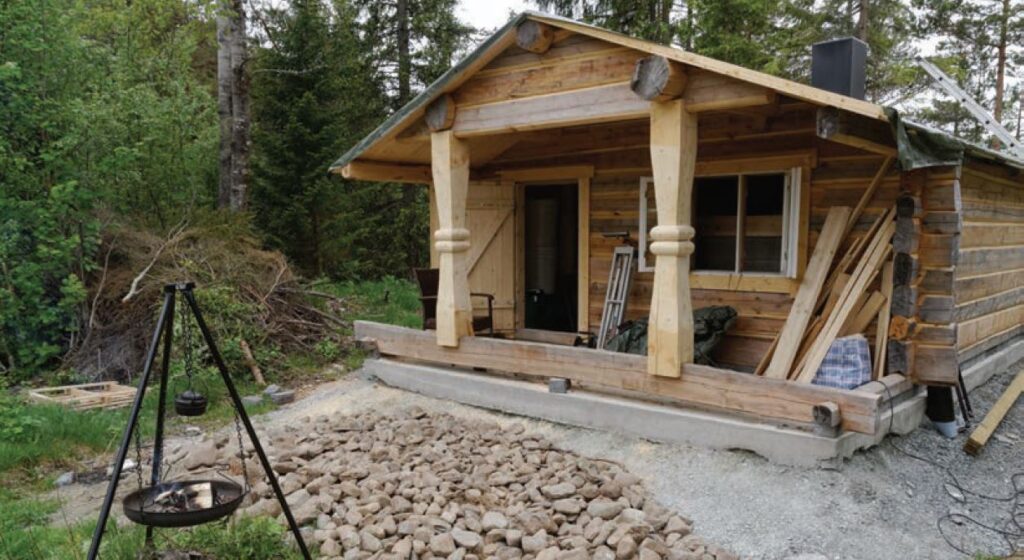
Roar Sandodden’s såinnhus. Skatval, Stjørdal, Norway. The malt for this traditional
Norwegian farmhouse is dried over alderwood smoke in a såinnhus similar to this.
(Photo: Lars Marius Garshol)
Photo & Recipe Reprinted with permission from Historical Brewing Techniques: The Lost Art of Farmhouse Brewing by Lar Marius Garshol (2020, Brewers Publications)
Jørund’s stjørdalsøl won the Norwegian farmhouse ale brewing championship in 2017 and placed second in 2018. It is not really possible to emulate this beer with commercial malt because it will not taste like the original. If you are serious about brewing this beer you will need to make your own Stjørdal-style malt (see p. 43 of Historical Brewing Techniques for process).
The specifications for this beer are based on measurements taken by Øyvind Arnesen from the Norwegian project “Vit hva du drikker.” Øyvind took readings of the beer at the farmhouse ale festival in Hornindal in 2018 using an Anton Paar Alex 500 alcohol and extract meter.
[For a somewhat more American take inspired by this recipe, see 100% Alderwood-Smoked Stjørdal-Style Homebrew Recipe.]
Batch volume: 25 liters (6.6 US gal.)
Original gravity: 1.084 (20.2°P)
Final gravity: 1.040 (10°P)
Bitterness: 0 IBU (no hops are boiled—see notes)
ABV: 5.7%

Ingredients
Malts
- 11 kg (24.3 lb.) Stjørdal-style malt
- 2 kg (4.4 lb.) white sugar (may replace ⅓ of it with dark syrup or rock candy)
Hops
- 15 g (0.5 oz.) Hersbrucker hops (2.3% AA) @ mash
Additional Items
- 4 liters of juniper (not compressed)
Yeast
- 1/4 cube of Idun Blå bread yeast (but see variations)
Brewing Notes
The traditional method for making this stjørdalsøl was to have the mash in the lauter tun, run off the wort, heat it in the kettle, then pour it back. The wort would be recirculated like this until the mash was hot enough. Today, Jørund uses a relatively modern setup with a kettle that has a built-in electric heater. He runs off and pours the wort back just to recirculate the mash. The two methods should yield similar results.
Place the hops, juniper, and grist in the kettle and pour cold water over it all. Leave the mix overnight. It is important that the temperature stays below 10°C (50°F) all the time. The next morning, start heating and circulating the wort until it reaches 50°C (122°F), which should take about 2.5 hours. Pause there for 20 minutes, then keep heating for a couple of hours until the temperature goes a little above 70°C (158°F). Keep it there for about two hours.
Run off the wort. Following Jørund’s method, taste the wort to judge how sweet it is, which, if using traditional Stjørdal-style malt, will vary with the quality of the grain and the malting process. Adjust the amount of sugar accordingly. Stir the sugar in while the wort is still hot so that the sugar dissolves easily.
Cool the wort to the appropriate pitching temperature, which depends on the yeast, then pitch while screaming as loud as you can. “The yeast scream is very important,” says Jørund with a smile.
Jørund usually uses Norwegian baker’s yeast (Idun Blå), pitching a ¼ cube at 22°C (72°F).
Ferment 4–8 days. Jørund decided whether the beer has finished fermenting by tasting it and judging the activity in the fermentor. Based on the specifications above, expect an extract efficiency of 46% with an apparent attenuation of 50%.
In practice, this beer has zero IBU from the hops, since the hops are never boiled. This may sound unbalanced, but the smoke, juniper, and raw ale character make it work better than one might expect. Serve with very low carbonation.
Variations
Jørund has used Safale US-05 at 22–24°C (72–75°F), fermented for about a week. Personally, I thought his version with this yeast was not as good as the others: thinner, with more prominent ashy smoke, but otherwise more neutral.
Jørund has also successfully used the #11 Lida kveik. He mixes several generations of kveik by dropping them dry into 33°C (91°F) wort and fermenting for 4–5 days. This was the version that won in 2017 and it was highly acclaimed by many tasters.
* By Jørund Geving; Morten Granås; Jogeir Halland; Klostergården bryggeri; and Roar Sandodden.
† Based on many conversations with Roar Sandodden and Jørund Geving, as well as interviews at eight såinnhus, and three major tasting sessions.
